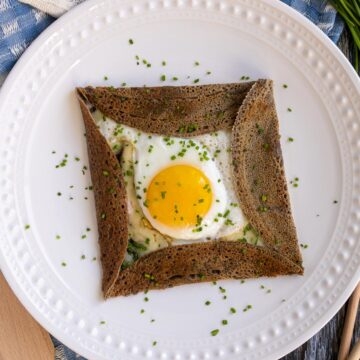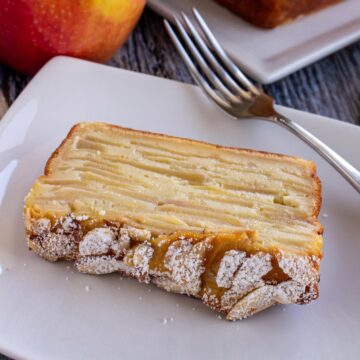Tartiflette is the ultimate comfort food! It’s made of sliced potatoes, bacon, onions, cheese, and pure love. It’s perhaps one of the best cheesy carb creations you’ll ever try! This is what cozy Alpine cuisine is all about.

If you love potatoes, bacon, onions, and cheese, you will love Tartiflette. It’s a beloved après-ski favorite originating from the Haute-Savoie region of the French Alps. Although it’s extremely popular in the colder months of the year, I can’t imagine a time of year when I wouldn’t welcome a plate of gooey, cheesy tartiflette.
Finding the “correct” type of cheese to make authentic Savoyard tartiflette in the United States will prove impossible. That’s because French Reblochon cheese, which is the official cheese used in tartiflette, cannot be imported into the US because it’s unpasteurized and made with raw milk.
Even if you find something labeled as “Reblochon cheese,” it will not be the same product as what you can get in France. Don’t panic! You can still make a fantastic tartiflette with some alternative, deliciously similar cheese options.

Aside from sourcing the right cheese, tartiflette is otherwise quite simple to make! Just boil, peel, and slice some potatoes, cook the bacon and onions, and then assemble into a layered casserole with cheese before baking.
It really is the epitome of comfort. You don’t need to be skiing in the French Alps to enjoy this dish. Just follow the recipe and treat yourself to a plate of carby, cheesy comfort. Swoon!
Ingredient notes

- Potatoes: Use a waxy type of potato, such as Yukon gold. They are better at retaining their shape and not falling apart.
- Bacon: Use slab or thick-cut bacon and either dice it into cubes or slice it into lardons (little strips about ¼-inch wide and 1 inch long).
- Cheese: Authentic Savoyard tartiflette is made with Reblochon cheese. It’s a soft rind cheese that has been unavailable for import to the United States since 2004, as it is unpasteurised and made with raw milk. You can find some pasteurized cheeses that are similar in the US, which is why the recipe calls for Reblochon-style cheese. Aim for a cheese with a soft rind that is made from cow’s milk. For this post and its photos I was able to have a local gourmet grocery store (Fox Point Grocers) special order a wheel of Préféré de nos Montagnes for me–it never hurts to ask your local cheese shop(s) or specialty foods shops if they can do the same. Here are some examples of cheeses you could try:
- Préféré de nos Montagnes (preferred choice; what I’ve used in these photos)
- Delice du Jura (preferred choice)
- Jasper Hill Willoughby
- Jasper Hill Moses Sleeper
- Brie
- Camembert
- Taleggio
- Délice de Bourgogne (this is a type of Brillat-Savarin cheese, a triple cream cheese–think of it as an extra rich version of Brie, although a bit more pungent. It’s not really the right cheese but it’s an interesting and tasty variation)


How to make it
Place potatoes in a large pot and cover with cold water.

Season generously with salt and bring to a boil over high heat. Then lower the heat and simmer until tender and easily pierced with the tip of a paring knife, about 20 to 30 minutes. Drain and set aside to slightly cool.
Meanwhile, place the rack in the center of the oven and preheat to 375°F (190°C). Place the diced bacon in a cold skillet or saute pan and place over medium heat. Allow the bacon to render and start to crisp, stirring occasionally, about 8 minutes. If there is a lot of rendered fat, remove some of the excess leaving only about 1 tablespoon in the pan.


Add the sliced onion and season with salt and pepper. Continue to cook, stirring regularly, until the onions soften, about 5 to 7 minutes.


Add white wine and cook until most of it evaporates, about 3 to 5 minutes. Set aside.


Peel and slice the potatoes into ¼-inch-thick slices.

Arrange half the slices in the bottom of either a 10-inch cast iron skillet or a 3-quart baking dish. Season with salt and pepper.

Top with half the bacon, onion and white wine mixture and then half the cheese.


Repeat with the remaining potato slices, season them, and then top with the remaining onion, bacon, and wine mixture.


Drizzle the heavy cream or dollop the crème fraîche over the top and then arrange the remaining slices of cheese evenly.


Bake until golden brown and bubbling throughout, about 35 to 40 minutes.

Let it sit for about 5 to 10 minutes before serving to allow it to set.
Please scroll to the bottom of the post for the full recipe (in a printable recipe card) including ingredient amounts and detailed instructions.

Expert tips
Tartiflette is best enjoyed immediately. Store leftovers in the refrigerator for up to 3 days. For the best results, I prefer to store leftovers in a small baking dish (covered with foil) and then reheating in a 350°F (175°C) oven until heated through. Keep it covered with foil until it’s mostly heated through and then remove it near the end to finish heating until bubbly. How long it will take to reheat depends on the amount of leftovers and the size of the baking dish but plan for 15 to 20 minutes or longer if needed. Keep in mind that when reheating, the oil tends to separate from the cheese (similar to reheating macaroni and cheese).
Whether you want to trim off some of the rind off your cheese is a personal preference. For the record, I do NOT remove the rind from my cheese. My recommendation is to slice the cheese into slabs or planks about ¼-inch thick. I find it’s easier to distribute the cheese evenly this way. You could also cut the cheese into large discs parallel to your work surface, but they will yield thicker slabs and would be better to just arrange on top (rind side up) instead of layering in the middle as well.

For a fun alternative, you could bake tartiflette in smaller individual baking dishes or tiny cast iron skillets. You could also use a similar approach to baking a smaller amount to enjoy fresh one day and then assemble and bake the rest another day rather than reheating it. It will always taste best served immediately rather than reheated!
I have tested different methods of cooking the potatoes for this recipe.
- Method 1: peeling, slicing, and then boiling the potato slices
- Method 2: boiling the potatoes whole, peeling gently with a paring knife, and then slicing the potatoes
I recommend the second method, which is what I share in my recipe. It takes longer for the potatoes to boil, however it avoids the potatoes becoming waterlogged and potentially overcooking and falling apart. Additionally, in the time that it takes to boil the potatoes, you can simultanesouly cook the bacon and onion mixture so the longer time cancels out.
I also prefer slicing the potatoes about ¼-inch thick and find it easier to distribute into 2 even layers in my baking dish. Thicker slices would yield less total slices and leave gaps. To slice them that thin before boiling them could be a disaster, so that's yet another reason to boil whole and then peel and slice.

FAQ
So here’s the thing. Even if you were to omit the bacon, the types of cheese you would use to make tartiflette are actually NOT vegetarian. All of these Reblochon-style soft rind cheeses are typically made with animal rennet, so they aren’t vegetarian. You are welcome to get creative and try other vegetarian cheeses, but the experience, flavor, and overall results will vary.
To some degree, yes. Cook the potatoes and the bacon/onion mixture up to a couple days in advance and refrigerate them separately until needed. Then, assemble the layers and bake. I don’t recommend assembling the entire casserole in advance because the sliced cheese can dry out. Although you could also bake the entire casserole and then reheat it in the oven, the oil tends to separate from the cheese when you do this, so it's not the best method.
Serve tartiflette with a green salad dressed with vinaigrette. The tart and acidic flavors in the salad will balance the rich cheese in the dish.
To drink, complement your tartiflette with a nicely chilled glass of white wine. All the better if you can find a wine from the Savoy / Savoie region of France! It would also pair nicely with a Chardonnay or a Gewürztraminer from Alsace. Again, the natural acidity in the wine will help cut through the richness of the cheesy tartiflette.

Other recipes you may like
- Älplermagronen (Swiss Alpine Macaroni and Cheese)
- Kasnocken (Austrian Spaetzle with Cheese and Onions)
- Flammkuchen / Tarte Flambée (German Pizza with Bacon and Onions)
- Schinkennudeln (German Ham and Cheese Noodle Casserole)
- Zwiebelkuchen (German Onion Pie)
- Soupe de Chalet (Swiss Cheese and Potato Soup)
- Pasta alla Norcina (Creamy Pasta with Sausage)
- Túrós Csusza (Hungarian Cottage Cheese Noodles)
Tried this recipe? Please leave a star ⭐️⭐️⭐️⭐️⭐️ rating in the recipe card below and/or a review in the comments section further down the page. You can also follow me on social media on Facebook, Instagram, and Pinterest!

Tartiflette (French Potato, Bacon and Cheese Gratin)
Ingredients
- 2 ¼ pounds (1 kg) Yukon gold potatoes (or other waxy potatoes)
- ¼ pound (113 grams) slab or thick-cut bacon diced
- 1 large onion or 2 small onions halved and thinly sliced
- Kosher salt and freshly ground black pepper
- ¾ cup dry white wine
- ¼ cup heavy cream or crème fraîche
- 1 pound (445 grams) Reblochon-style cheese sliced into slabs about ¼-inch-thick
Instructions
- Place potatoes in a large pot and cover with cold water. Season generously with salt and bring to a boil over high heat. Then lower the heat to medium and simmer until tender and easily pierced with the tip of a paring knife (they can be slightly undercooked as they will continue to cook in the oven), about 20 to 30 minutes (this will entirely depend on size of your potatoes). Drain and set aside to slightly cool.
- Meanwhile, place the rack in the center of the oven and preheat to 375°F (190°C). Place the diced bacon in a cold skillet or saute pan and place over medium heat. Allow the bacon to render and start to crisp, stirring occasionally, about 8 minutes. If there is a lot of rendered fat, remove some of the excess leaving only about 1 tablespoon in the pan.
- Add the sliced onion and season with salt and pepper. Continue to cook, stirring regularly, until the onions soften, about 5 to 7 minutes.
- Add white wine and cook until most of it evaporates, about 3 to 5 minutes. Set aside.
- Peel and slice the potatoes into ¼-inch-thick slices. Arrange half the slices in the bottom of either a 10-inch cast iron skillet or a 3-quart baking dish. Season with salt and pepper. Top with half the bacon, onion and white wine mixture and then half the cheese. Repeat with the remaining potato slices, season them, and then top with the remaining onion, bacon, and wine mixture.
- Drizzle the heavy cream or dollop the crème fraîche over the top and then arrange the remaining slices of cheese evenly (rind side up, depending on how you sliced it). If the dish seems really full and might bubble over when baking, place it on top of a baking sheet before transferring to the oven. Bake until golden brown and bubbling throughout, about 35 to 40 minutes. Let it sit for about 5 to 10 minutes before serving to allow it to set.
Notes
- Authentic Savoyard tartiflette is made with Reblochon cheese. It’s a soft rind cheese that has been unavailable for import to the United States since 2004, as it is unpasteurised and made with raw milk. You can find some pasteurized cheeses that are similar in the US, which is why the recipe calls for Reblochon-style cheese. Here are some examples of cheeses you could try:
- Delice du Jura (preferred choice)
- Préféré de nos Montagnes (preferred choice; what I’ve used in these photos)
- Jasper Hill Willoughby
- Jasper Hill Moses Sleeper
- Brie
- Camembert
- Taleggio
- Délice de Bourgogne (this is a type of Brillat-Savarin cheese, a triple cream cheese–think of it as an extra rich version of Brie, although a bit more pungent. It’s not really the right cheese but it’s an interesting and tasty variation)
- Tartiflette is best enjoyed immediately. Store leftovers in the refrigerator for up to 3 days. For the best results, I prefer to store leftovers in a small baking dish (covered with foil) and then reheating in a 350°F (175°C) oven until heated through. Keep it covered with foil until it’s mostly heated through and then remove it near the end to finish heating until bubbly. How long it will take to reheat depends on the amount of leftovers and the size of the baking dish but plan for 15 to 20 minutes or longer if needed. Keep in mind that when reheating, the oil tends to separate from the cheese (similar to reheating macaroni and cheese).
Nutrition
*All nutritional information is based on third-party calculations and should be considered estimates. Actual nutritional content will vary with brands used, measuring methods, portion sizes and more.*






Comments
No Comments